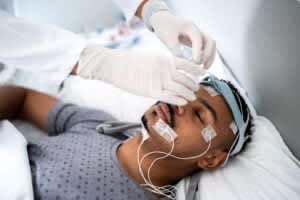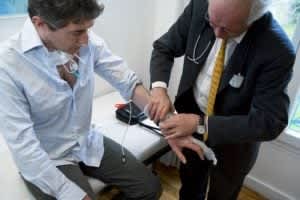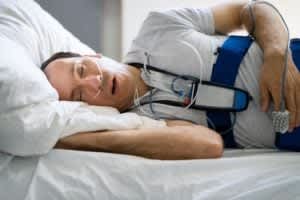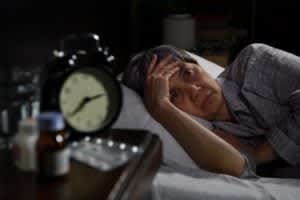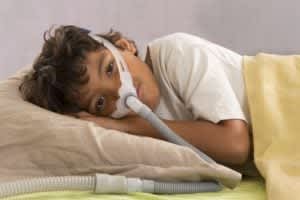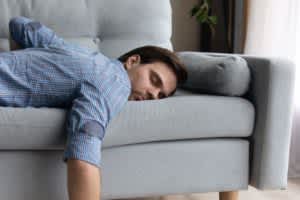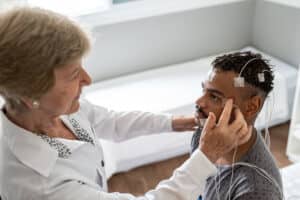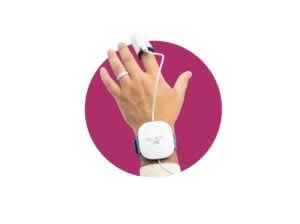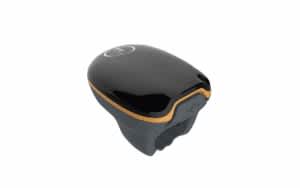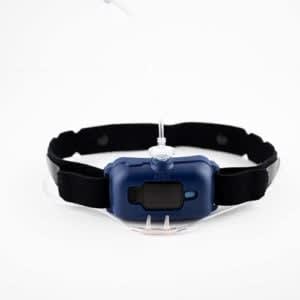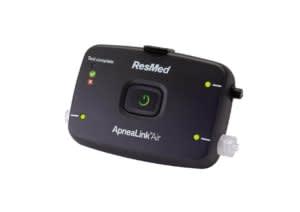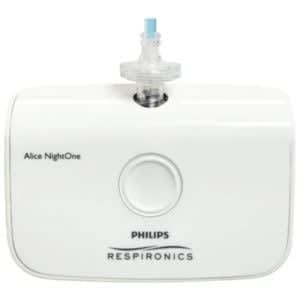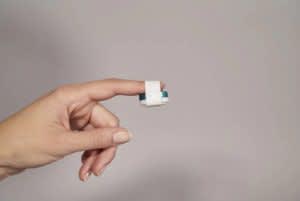Price:
$450When you buy through our links, we may earn a commission. Products or services may be offered by an affiliated entity. Learn more.
Zmachine Synergy Review
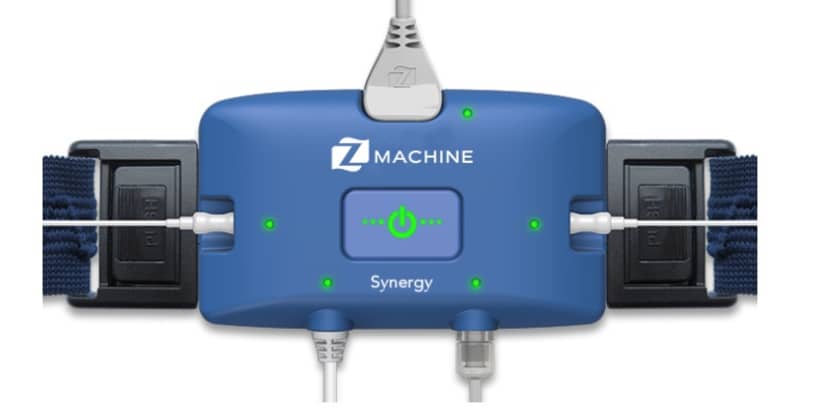
Zmachine Synergy

Sleep Foundation Special Offer
Use this SleepFoundation.org link for the most current discount on General Sleep products
The Zmachine Synergy is an at-home sleep test that can help doctors detect and diagnose obstructive sleep apnea (OSA). It monitors nine different sleep metrics and is one of the most thorough at-home tests on the market. People who suspect that they have OSA can order a test kit, which includes a device rental, shipping, and results reviewed by a board-certified sleep specialist.
We’ll explore what makes the Zmachine Synergy unique, how it works, what it monitors, and how the specific sleep data can help doctors better understand your health. We’ll also cover the device’s pros and cons so you can decide if it’s the right at-home sleep test for your individual needs.
What Is Obstructive Sleep Apnea (OSA)?
People with OSA often experience choking, snorting, and gasping while sleeping. This happens when the upper airway becomes obstructed by the tongue, soft palate, or muscles in the throat. This muscle collapse narrows the breathing passage and makes it difficult for a person to breathe regularly, causing apneas, hypopneas, or both.
Apnea refers to a pause in breathing, while hypopnea means breaths are shallower than usual. Medical professionals determine the severity of a person’s OSA by monitoring how many apneas and hypopneas a person has while sleeping. This measurement, called the apnea-hypopnea index (AHI), is the average number of apneas and hypopneas a person has during one hour of sleep. A person must have an AHI score of at least 5 to be diagnosed with OSA.
| AHI Score | Sleep Apnea Severity |
|---|---|
| 5-15 | Mild OSA |
| 15-30 | Moderate OSA |
| 30 or higher | Severe OSA |
In the U.S., between 10 and 30 percent of adults experience sleep apnea, though many cases go undiagnosed. The most common symptoms include loud and frequent snoring, morning headaches, dry mouth, irritability, and feeling tired during the day. Certain populations are more at-risk of developing sleep apnea, including aging people, men and people assigned male at birth, those with a high body mass index (BMI), and specific facial shapes and features.
Untreated OSA can result in serious health problems such as diabetes, cardiovascular disease, depression, and an increased risk of workplace accidents. If you suspect that you may have sleep apnea, you’ll need to complete an in-person or at-home sleep study reviewed by a doctor. Following a diagnosis, your health care team may decide to prescribe continuous positive airway pressure (CPAP) therapy, which is one of the most successful OSA treatment methods.
How Does the Zmachine Synergy Work?
The Zmachine Synergy is a comprehensive at-home test that goes beyond what many other at-home tests offer. The device records nine different data points to provide physicians with a wide spectrum of health information.
- Electroencephalogram (EEG): The Zmachine Synergy performs an EEG, a test that uses electrodes on your head to record your brain’s electrical signals. This is a unique feature that most other at-home tests don’t have and allows doctors to detect your sleep stage. When screening for OSA, this test can help doctors understand how your breathing and sleep patterns relate to one another.
- Blood oxygen level: Your blood oxygen level (spO2) informs doctors how much oxygen is present in your blood. Low blood oxygen levels can reflect poor health and be indicative of breathing problems. In someone with OSA, low blood oxygen levels can correlate with apneas and hypopneas. The Zmachine Synergy at-home test measures your blood oxygen level using the pulse oximeter attached to your finger.
- Respiratory airflow: The nasal cannula measures the pressure of each of your respirations, which can help detect shallow breathing as well as breathing cessation.
- Respiratory effort (RIP): The belt around your chest monitors the effort it takes for you to breathe. It can detect your lung volume by recording your chest’s movements. Physicians use this reading to learn about your breathing quality.
- Amount of snoring: Loud and frequent snoring is one of the most common symptoms of sleep apnea. This data point detects and records snoring frequency.
- Body position: The monitor tracks your body position and records the data to determine if there’s a relationship between your breathing patterns and sleeping positions.
- Actigraphy (body movement): In addition to body position, the Zmachine Synergy tracks body movement on three different axes.
- Pulse: Your heart rate data allows your physician to compare it to respiration effort and frequency.
- CPAP flow and pressure: You can use this monitor with a CPAP machine, which allows your health care team to measure your sleep data with and without positive air pressure delivery. You can use the CPAP interface to connect your CPAP mask and hose to the device.
Each metric provides helpful data on its own, but doctors can get a better picture of your overall sleep health when they compare all nine data points. Because of this, it’s important to ensure that all components function correctly during the sleep study. Failing to record every metric properly might result in incomplete or incorrect information.
It’s also critical to understand the steps to take before and after your sleep test. The at-home test is just one step toward treating OSA.
- Step 1: First, consider what type of at-home sleep test you need. The Zmachine Synergy is a type 2 test, which is the most comprehensive kind of at-home test. While not everyone requires a comprehensive test, it’s a good choice for people who need information beyond what type 3 and 4 tests provide.
- Step 2: You can purchase an at-home sleep study that includes a rental of the Zmachine Synergy. Use the company’s online checkout to purchase the test, which will take up to three days to ship to your house.
- Step 3: Read the comprehensive instructions that are included with the device before using the test. Unlike other at-home tests, the Zmachine Synergy doesn’t alert users whether or not the study was successful. Mail back the test after one night’s use using the included prepaid packaging. If you need to retake the test, The Sleep Doctor will notify you and reissue the test for the cost of shipping. You do not need to pay the full test fee to do a second at-home study.
- Step 4: Your results will be reviewed by a board-certified sleep specialist and sent via secure email two to three days after equipment is recieved. Your results will include your AHI score and a comprehensive report that indicates whether or not you have sleep apnea.
- Step 5: If you receive a sleep apnea diagnosis, you’ll need to schedule a visit with your physician to discuss your results and treatment plan. A prescription is required for any type of OSA treatment, including CPAP therapy. If you don’t have a sleep specialist, you can schedule a telehealth visit with the health care team.
How Do You Set Up and Use the Zmachine Synergy?
The Zmachine Synergy has more components and sensors than other at-home sleep tests, but it’s still fairly simple to operate. There are four main components that take unique measurements to help your doctor determine whether or not you have OSA. Each of these wearable pieces connect to a monitoring device that stores your sleep data.
Sensors on the monitor show if each accessory is connected and working properly. The monitor also indicates whether it collected enough data during your study. There are a few important steps to take in order to ensure the Zmachine Synergy functions correctly.
- Use an alcohol wipe to clean the back of your neck and behind your ears. Then, attach a flexible sensor pad behind each ear, taking care not to touch the middle of the sensor. Place the third sensor pad on the back of your neck. Let the pads adhere to your skin for at least 20 minutes.
- Adjust the effort belt to fit your body using the adjustable tabs. Make sure the shirt you’re wearing is loose and comfortable before placing the belt around your chest. The belt should sit high on your chest, just below your armpits. Click the belt ends into the monitor and check that the device is in the middle of your chest.
- Connect the white cords hanging from the monitor to the snaps on the effort belt. Then, insert the square end of the EEG cable into the top of the monitor. Connect the black wire to the sensor on your neck and the white wires to the sensors behind your ears.
- Insert the nasal cannula into your nostrils and place the tubing over your ears. Use the sliding adjuster to tighten the tubing. Tape the tubing to your cheeks to ensure that it stays in place while you sleep. Then, twist the cannula into the device.
- Place the finger probe over your finger and tape the cord to the back of your hand. Clip the cord to the effort belt on either side of the monitor. Nail polish and fake nails should be removed, as they might affect the data’s accuracy.
After correctly attaching each piece, you can start the test and go to bed. You can rest in any sleeping position, including on your stomach. Press the button at the monitor’s center until the lights turn green. Yellow lights signify that a sensor is not properly attached and green means the device is ready to begin recording. In the morning, complete the test by holding the center button until the sensor lights turn orange.
Once a doctor reviews your data, they’ll inform you if the device collected adequate information. The company will ship the device back to you and help you set up another test if necessary.
Who Should Use the Zmachine Synergy?
The Zmachine Synergy is best for people who need the most thorough type of at-home sleep test available. The study is approved by the U.S. Food and Drug Administration (FDA) and has an EEG test, which measures how breathing changes during different sleep stages. This test is more similar to a traditional in-person sleep study than type 3 and 4 at-home sleep tests, which don’t include EEG testing or information on brain activity.
The Zmachine Synergy has more components than simpler at-home tests do, and the monitor doesn’t alert users if the test wasn’t successful. This option is best for people who are comfortable following the test instructions exactly as directed and waiting up to a week for a second try if necessary.
This type of test is excellent for certain types of people who think they may have sleep apnea, including:
- Those looking for sleep stage data: This study includes an EEG test, which measures brain activity to detect sleep stages.
- Pilots: The Zmachine Synergy is approved by the Federal Aviation Administration (FAA), meaning it meets first-class medical requirements for pilots.
- Those willing to spend more: Since this test includes more data than other at-home tests, it has a higher price-point. While it’s still more affordable than an in-person lab test, the Zmachine Synergy is more expensive than basic at-home tests.
- People who don’t need immediate results: Users are not able to tell if the test was performed correctly by looking at the monitor. The company’s team will alert you if a second test is necessary, and you’ll need to wait up to a week to take the test a second time.
While there are many advantages to using the Zmachine Synergy, the test is not the right match for everyone. Budget shoppers and those who don’t need sleep stage data should consider a type 3 test that’s easier to use and more affordable.
Pros and Cons of the Zmachine Synergy
The Zmachine Synergy has several advantages over both in-person sleep tests and other types of at-home tests.
- Increased accuracy: This type 2 test has more data points than type 3 and 4 tests and can provide more accurate information as a result.
- EEG test: The EEG test provides your physician with sleep stage data, which can help them better understand when your breathing is most difficult.
- At-home test with advanced diagnostics: This test bridges the gap between in-person tests and at-home tests. It records much of the same data as traditional in-person sleep studies but can be performed at home without help from a doctor or technician.
Though it has many excellent features, this test has a few characteristics that are important to keep in mind before you purchase a kit.
- Cost: This is one of the most expensive at-home tests available. While it’s still more affordable than an in-person test, it may be several hundred dollars more than an at-home test with basic data points.
- Many components: The EEG test requires that sensors are placed behind the ears and on the neck. You’ll also need to wear the effort belt, nasal cannula, and pulse oximeter, which each have their own wires. Users may not find the Zmachine Synergy as comfortable when compared to more streamlined options.
- No morning alerts: There are sensors on the monitor that indicate whether the components are connected correctly, but the sensors do not tell you whether the test was successful. You’ll have to wait for your report to learn whether or not the test worked.
Cost, Shipping, and Returns
Compared to other at-home sleep tests, the Zmachine Synergy is a costly option. However, it’s still more affordable than an in-person lab test. Most online companies don’t accept insurance, but you can use your health savings account (HSA) to pay for the test kit or check with your insurance provider to see if the test qualifies for reimbursement. People with Medicare can apply for reimbursement if they have clinical symptoms that indicate OSA.
If you purchase the Zmachine Synergy at-home sleep test kit, shipping and return shipping are both free. The kit arrives within three days, and you’ll receive your sleep report two to three days after returning your device. You don’t need a prescription to purchase the kit, though it’s not available to those in Arkansas, Delaware, Hawaii, or North Dakota. People in Guam need a referral to order a sleep test.
You may be able to find this device elsewhere, but likely only as a rental. While it’s cost-prohibitive for customers to purchase on their own, they also only need to use the device one or two nights.
The device has a two-year warranty for the monitor and a one-year warranty for the effort belt, cables, and pulse oximeter.
The Bottom Line
The Zmachine Synergy is a top-of-the line at-home sleep test that provides users and their health care teams with very comprehensive sleep health information. It has nine different metrics that record sleep data related to OSA. This at-home study includes EEG sleep stage detection, which most other at-home tests don’t include. The device is an excellent option for anyone who wants an at-home test that provides extremely thorough information.
However, the extra data comes at a cost. The Zmachine Synergy is more expensive than most other devices and is not as user-friendly to operate. Overall, it’s a fantastic choice for people who need a comprehensive at-home test and those willing to jump through a few extra hoops in order to get extensive sleep health information.

Still have questions?
Our product experts have extensive experience testing just about every sleep product on the market. Send an email to AskAnExpert@sleepfoundation.org or call us at (877) 672-8966 with your questions and we’ll help you find exactly what you’re looking for.

